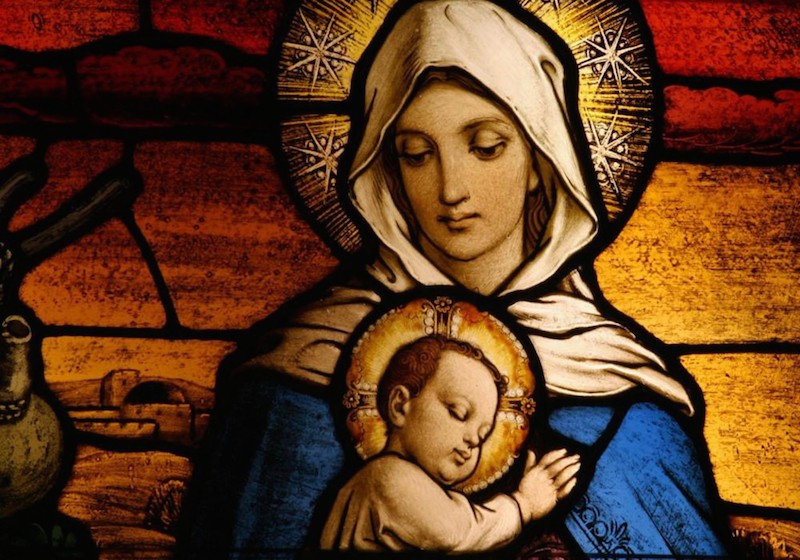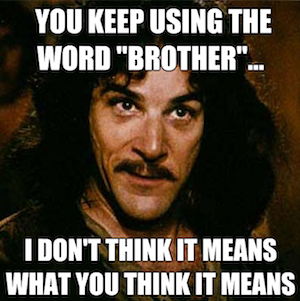The “brothers” of Jesus
A friend recently sent me a Facebook message asking about a passage from the Bible she had heard at Mass:
“Can you shed light on the “brothers” of Jesus in the gospel today for me? James, Joseph, Simon and Judas…”
The passage referred to was from Matthew’s Gospel:
They were astonished [at Jesus] and said, “Where did this man get such wisdom and mighty deeds? Is he not the carpenter’s son? Is not his mother named Mary and his brothers James, Joseph, Simon, and Judas? Are not his sisters all with us? …” – Matthew 13:54-58
So what do we make of these guys, these “brothers” of Jesus?
Mary, Mary, quite contrary…
The Catholic Church teaches that Mary was not only a virgin at the time of Jesus’ birth, but also that she remained a virgin for the rest of her life. However, doesn’t the above passage mention the “brothers…[and]…sisters” of Jesus? Doesn’t that prove that Mary had other children after Christ?
As you can imagine this issue is often raised in Catholic-Protestant dialogue, since the doctrine of the Perpetual Virginity of Mary found in Sacred Tradition seems to many Protestants to obviously contradict Sacred Scripture.
There’s a lot which could be said on this subject, but in this post I would like to offer a brief response and explain how Catholics understand the mention of Jesus’ “brothers”.

“We are FAM-I-LY…”
 Before looking at passages such as the one quoted above, we must realize that Hebrew and Aramaic had few words for describing the relationships between family members. A few terms were used and re-used, with little regard, biologically speaking, for the closeness of the relationship being described:
Before looking at passages such as the one quoted above, we must realize that Hebrew and Aramaic had few words for describing the relationships between family members. A few terms were used and re-used, with little regard, biologically speaking, for the closeness of the relationship being described:
1. Ancestors were generally called “mother” and “father”
2. Descendants were generally called “son” and “daughter”
3. All other relations were generally called “brother” and “sister”
So although virtually all of the New Testament was written in Greek, the documents were written from within this Semitic worldview. Therefore, we should be wary of assuming too readily that the words “brother” and “sister” literally refer to full-blood siblings.
The term “brother” could, for example, refer to a half-brother. We do find some early sources which talk about St. Joseph’s children from a previous marriage. Therefore, some of these “brothers” could be St. Joseph’s children from a previous wife who died before he married Mary. There are several other possible usages for the word “brother” , including cousins, relatives through marriage etc. For this reason, I personally think “kinsman” would be a better translation when rendered in English…
The case of “brother” Abraham
In the Old Testament we find a clear example of this more general use of the word “brother”. In the book of Genesis, Lot is described as Abram’s “brother”:
And [Abram] brought back all the goods, and also brought again his brother Lot, and his goods… – Genesis 14:16 (KJV)
However, we know that Abram and Lot weren’t literally siblings. In fact, Lot was Abram’s nephew:
Now these are the generations of Terah: Terah begat Abram, Nahor, and Haran; and Haran begat Lot. – Genesis 11:27
One possible objection to this example is that this passage is found in the Book of Genesis, the Old Testament, and was therefore written in Hebrew, rather than Greek like the Gospel passage quoted earlier. However, we know that the Greek translation of the Old Testament used at the time of Jesus, known as The Septuagint (LXX), used the Greek word “adelphon” (ἀδελφὸν), the same word used in the passage from Matthew quoted at the beginning of this post to describe the relationship between Jesus, James, Joseph etc.
The case of “brother” James and “brother” Joseph
Two of the “brothers” mentioned in the initial Gospel passage are worth further examination. “James” and “Joseph” (sometimes rendered as “Joses”) are mentioned again, albeit indirectly, towards the end of the Passion narrative:
There were also many women there, looking on from afar, who had followed Jesus from Galilee, ministering to him; among whom were Mary Magdalene, and Mary the mother of James and Joseph, and the mother of the sons of Zebedee. – Matthew 27:55-56
It’s pretty clear that these “brothers” are not sons of the Blessed Virgin. The Mary mentioned here isn’t the Blessed Virgin since the Evangelist would have referred to her as being the mother of the Lord, rather than mother of James and Joseph. The parallel Gospel accounts of the crucifixion do much to confirm this, but that’s another post for another time.
Mary’s other son…
Having said all that, I think the strongest case for Jesus being an only child is made by looking at the end of crucifixion in John’s Gospel:
When Jesus saw his mother, and the disciple whom he loved standing near, he said to his mother, “Woman, behold, your son!” Then he said to the disciple, “Behold, your mother!” And from that hour the disciple took her to his own home. – John 19:26-27
A Jewish widow would typically be cared for by her sons. However, in this passage, Jesus acts as though Mary had none but Himself. He doesn’t place her in the care of a family member, but in the care of the Beloved Disciple, John the Apostle! If Mary did have any other children, this would have been a tremendous insult to them.
There is more to be said on this subject, but hopefully this has provided a good introduction.
The article The “brothers” of Jesus first appeared on RestlessPilgrim.net
In the Eastern Tradition, St. Joseph is thought to be an older widower and had children from his first marriage. My patron saint, James the Brother of the Lord, is thought to be Joseph’s son. In many icons of the flight to Egypt the Holy Family has not three members but a fourth – James.
http://thehandmaid.wordpress.com/2012/12/26/the-commemoration-of-the-flight-into-egypt/
Pingback: The “brothers” of Jesus - CATHOLIC FEAST - Every day is a Celebration
It should also be stressed – heavily – that would Mary have been left without any male to care and watch over her (as St. Joseph had long since passed) she would have been left to the streets, a beggar, and truly thrown to the wolves. Women in this century did not work and those that did not have a husband were either still living with their father’s family or were lain destitute. By placing John as the caretaker of our Lady Jesus did his mother the greatest temporal favor: make certain she will be provided and cared for the rest of her Earthly life.
The stress always seems to come down to the translation of “brother” in the OT or NT; more prudently a deep and introspective study of the classes and hierarchy of ancient Judea’s civilization should be at the forefront.
Hey Austin, welcome to Restless Pilgrim! Yup, I’d agree.